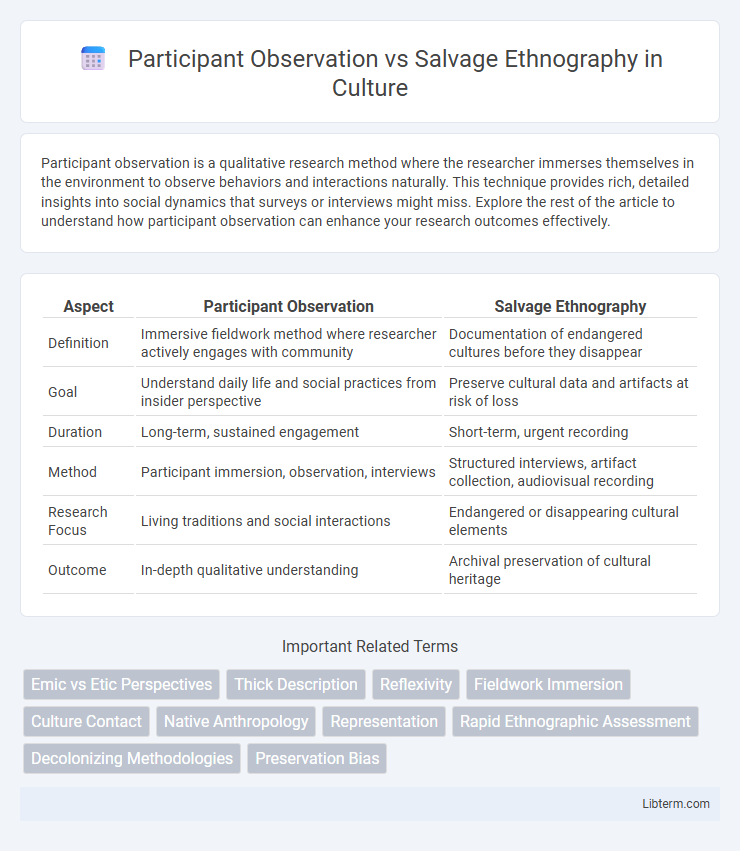Participant observation is a qualitative research method where the researcher immerses themselves in the environment to observe behaviors and interactions naturally. This technique provides rich, detailed insights into social dynamics that surveys or interviews might miss. Explore the rest of the article to understand how participant observation can enhance your research outcomes effectively.
Table of Comparison
| Aspect | Participant Observation | Salvage Ethnography |
|---|---|---|
| Definition | Immersive fieldwork method where researcher actively engages with community | Documentation of endangered cultures before they disappear |
| Goal | Understand daily life and social practices from insider perspective | Preserve cultural data and artifacts at risk of loss |
| Duration | Long-term, sustained engagement | Short-term, urgent recording |
| Method | Participant immersion, observation, interviews | Structured interviews, artifact collection, audiovisual recording |
| Research Focus | Living traditions and social interactions | Endangered or disappearing cultural elements |
| Outcome | In-depth qualitative understanding | Archival preservation of cultural heritage |
Introduction to Participant Observation and Salvage Ethnography
Participant observation is a qualitative research method where the ethnographer immerses themselves in a community to observe behaviors and social interactions firsthand. Salvage ethnography focuses on documenting the cultural practices and knowledge of indigenous or endangered groups before they disappear due to external influences or modernization. Both methods prioritize detailed cultural data collection, but participant observation emphasizes long-term engagement, while salvage ethnography aims at preservation of at-risk cultures.
Defining Participant Observation
Participant observation is a qualitative research method where the ethnographer immerses themselves in the community to observe and engage in daily activities, aiming to understand social behaviors from an insider perspective. This technique emphasizes firsthand experience and long-term interaction to gather rich, context-specific data. Unlike salvage ethnography, which primarily focuses on recording endangered cultures before they disappear, participant observation seeks ongoing, interactive learning within living cultural contexts.
Defining Salvage Ethnography
Salvage ethnography is an anthropological method aimed at documenting and preserving cultures perceived to be endangered or rapidly disappearing, often through detailed recording of rituals, language, and social practices. Unlike participant observation, which involves immersive, long-term engagement within a community to understand their everyday life and social dynamics, salvage ethnography typically emphasizes preservation over experiential insight. This approach emerged prominently in the early 20th century as ethnographers sought to capture the "authentic" aspects of indigenous cultures facing colonial disruption and modernization.
Historical Contexts of Both Methods
Participant observation emerged in the early 20th century through anthropologists like Bronislaw Malinowski during fieldwork in the Trobriand Islands, emphasizing immersive engagement to understand cultures from within. Salvage ethnography arose primarily in the late 19th and early 20th centuries, driven by concerns over colonial impacts and the perceived threat of cultural extinction among Indigenous peoples, prompting rapid documentation before traditional lifeways vanished. These methods reflect different historical imperatives: participant observation aims for deep cultural insight through prolonged interaction, while salvage ethnography prioritizes urgent preservation amid cultural disruption.
Methodological Approaches: Key Differences
Participant observation involves immersive, long-term engagement where researchers actively participate in the daily lives of their subjects to gain an in-depth understanding of cultural practices. Salvage ethnography focuses on the urgent documentation of endangered cultures through rapid data collection, often emphasizing preservation over prolonged engagement. The key methodological difference lies in participant observation's emphasis on sustained interaction and contextual insight, whereas salvage ethnography prioritizes the swift recording of cultural elements before they disappear.
Ethical Considerations and Critiques
Participant observation emphasizes immersive engagement with communities, raising ethical concerns about informed consent, researcher influence, and maintaining respectful relationships. Salvage ethnography faces critiques for its extraction of cultural materials under the guise of preservation, often disregarding community agency and reinforcing colonial power dynamics. Both methodologies demand critical ethical reflection to balance knowledge production with respect for cultural autonomy and integrity.
Data Collection Techniques Compared
Participant observation involves immersive, long-term engagement where researchers actively observe and interact within the community, enabling detailed qualitative data collection through direct experience and informal interviews. Salvage ethnography prioritizes rapid documentation of endangered cultures, relying heavily on structured interviews, artifact collection, and audiovisual recordings to preserve data before cultural loss occurs. The former emphasizes depth and contextual understanding, while the latter focuses on speed and comprehensive preservation of cultural elements.
Impact on Anthropological Research
Participant observation revolutionized anthropological research by promoting immersive, long-term engagement within communities, yielding rich, nuanced data on social behaviors and cultural practices. Salvage ethnography, primarily concerned with documenting disappearing cultures, provided valuable historical records but often lacked the depth and context offered by direct participation. The shift toward participant observation enhanced interdisciplinarity and reflexivity, fostering more dynamic and ethically grounded ethnographic methods.
Contemporary Applications and Relevance
Participant observation in contemporary anthropology remains a pivotal method for gaining in-depth cultural insights through direct engagement, facilitating nuanced understanding of social behaviors and practices in real-time settings. Salvage ethnography, while historically significant for documenting endangered cultures and languages, now informs digital archiving and revitalization projects aimed at preserving intangible cultural heritage amid globalization. Both approaches contribute to cultural sustainability, with participant observation enhancing ethnographic validity in dynamic contexts and salvage ethnography providing critical records for community-led cultural resurgence.
Conclusion: Choosing the Right Method
Choosing the right method between participant observation and salvage ethnography depends on research goals and cultural context. Participant observation excels in capturing dynamic social interactions through immersive engagement, while salvage ethnography prioritizes documenting endangered cultures and practices at risk of disappearing. Researchers must weigh the need for in-depth ongoing participation against the urgency of preservation to select the most effective ethnographic approach.
Participant Observation Infographic

 libterm.com
libterm.com